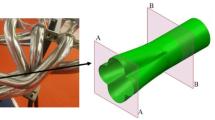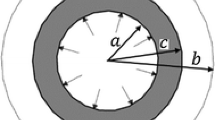Abstract
For the "thin walled and thick nozzle" high-pressure gas cylinder liner cannot be molded as a whole this problem, this paper puts forward a new technology route. A composite process based on thickening of the end and neck-spinning was designed. Through the finite element simulation to analyze the neck-spinning of the gas cylinder liner, the distribution law of equivalent stress and strain in the neck area after different passes of forming was investigated; the axial distribution of the three-way strain in different thickness layers is further discussed, and the influence laws of different process parameters on the equivalent stress and strain are derived and analyzed; the process parameters are also optimized and the optimal set of process parameters based on equivalent stresses and thickening factor is derived. The spinning experiments successfully produced a "thin walled and thick nozzle" monolithic cylinder liner, and compared with the simulation results to verify the accuracy of the model.



















Similar content being viewed by others
References
Li, Y., Fang, W., Lu, C., Gao, Z., Ma, X., Jin, W., Ye, Y., & Wang, F. (2019). Microstructure and mechanical properties of 34CrMo4 Steel for gas cylinders formed by hot drawing and flow forming. Materials, 12, 1351.
Ma, X., Song, B., & Wang, P. (2008). Reliability-based robust optimization design for high-pressure gas bottle of torpedo. Machinery Design & Manufacture, 4, 8–9.
Jin, W., Li, Y., Gao, Z., Yin, X., & Ma, X. (2018). Reliability analysis of integral hot deep drawing and cold flow forming process for large-diameter seamless steel gas cylinders. The International Journal of Advanced Manufacturing Technology, 97, 189–197.
Guo, Y., Xu, C., Han, J., & Wang, Z. (2020). New technique of precision necking for long tubes with variable wall thickness. Frontiers of Mechanical Engineering, 15, 622–630.
Lexian, H., & Dariani, B. M. (2009). Effect of roller nose radius and release angle on the forming quality of a hot-spinning process using a non-linear finite element shell analysis. Proceedings of the Institution of Mechanical Engineers Part B Journal of Engineering Manufacture, 223, 713–722.
Music, O., Allwood, J. M., & Kawai, K. (2010). A review of the mechanics of metal spinning. Journal of Materials Processing Technology, 66, 3–23.
Wong, C., Dean, T., & Lin, J. (2003). A review of spinning, shear forming and flow forming processes. International Journal of Machine Tools & Manufacture, 66, 1419–1435.
Roy, B. K., Korkolis, Y. P., Arai, Y., Araki, W., Iijima, T., & Kouyama, J. (2020). Experimental and numerical investigation of deformation characteristics during tube s-pinning. The International Journal of Advanced Manufacturing Technology, 110, 1851–1867.
Zoghi, H., & Fallahi, A. A. (2013). Finite element study of stress and strain state during hot tube necking process. Proceedings of the Institution of Mechanical Engineers Part B Journal of Engineering Manufacture, 227, 551–564.
Zoghi, H., Arezoodar, A. F., & Sayeaftabi, M. (2013). Enhanced finite element analysis of material deformation and strain distribution in spinning of 42CrMo steel tubes at elevated temperature. Materials & Design, 47, 234–242.
Zoghi, H., Fallahi Arezoodar, A., & Sayeaftabi, M. (2012). Effect of feed and roller contact start point on strain and residual stress distribution in dome forming of steel tube by spinning at an elevated temperature. Proceedings of the Institution of Mechanical Engineers Part B Journal of Engineering Manufacture, 226, 1880–1890.
Huang, C. C., Hung, J. C., Hung, C., & Lin, C. R. (2011). Finite element analysis on neck-spinning process of tube at elevated temperature. The International Journal of Advanced Manufacturing Technology, 56, 1039–1048.
Liu, G., Ding, H., et al. (2023). Optimization of hot spinning necking process for 6061 aluminum alloy gas cylinder based on numerical simulation. Hot Working Technology, 52, 89–93.
Zhang, Q., & Deng, C. (2022). Research on spinning forming process of thin-walled gas cylinders. Die & Mould Manufacture Monthly, 22, 4–8.
Zheng, Q., Yu, Y., et al. (2018). Simulation and process optimization of hot neck-spinning for accumulator shell. Forging & Stamping Technology, 43, 73–78.
Wang, Z., Fu, J., et al. (2016). Study on forming process of large outer concave section ring on the basis of forging blank. China Metalforming Equipment & Manufacturing Technology, 51, 80–83.
Shao, F., Ren, F., et al. (2013). Numerical simulation research on the process of hot neck-spining formation for the seamless cylinder. Development and Application of Materials, 28, 102–106.
Lyu, Z., Sato, Y. S., Tokita, S., Zhao, Y., Jia, J., & Wu, A. (2021). Microstructural evolution in a thin wall of 2Cr13 martensitic stainless steel during wire arc additive manufacturing. Materials Characterization, 182, 111520.
Wang, X., Fan, L., Ding, K., Xu, L., Guo, W., Hou, J., & Duan, T. (2021). Pitting corrosion of 2Cr13 stainless steel in deep-sea environment. Journal of Materials Science & Technology, 64, 187–194.
Wang, S., Cui, Q., Zou, J., & Zhang, Z. (2020). Impact wear mechanism of 2Cr13 steel under small stress multi-impact conditions—ScienceDirect. Wear, 462–463, 203492.
Ge, J., Ma, T., Han, W., Yuan, T., Jin, T., Fu, H., Xiao, R., Lei, Y., & Lin, J. (2019). Thermal-induced microstructural evolution and defect distribution of wire-arc additive manufacturing 2Cr13 part: Numerical simulation and experimental characterization. Applied Thermal Engineering, 163, 114335.
Ren, F., Chen, F., Chen, J., & Tang, X. (2018). Hot deformation behavior and processing maps of AISI 420 martensitic stainless steel. Journal of Manufacturing Processes, 31, 640–649.
Kuang, W., Xia, Q., & Feng, R. (2006). Mechanism research for 3D non-axisymmetric thin-wall tube offset spinning. Chinese Journal of Mechanical Engineering, 19, 217–222.
Liu, Y., Chai, J. C., Cui, X., Yan, W., Li, N., & Jin, L. (2023). Multi-objective optimization of air dehumidification membrane module based on response surface method and genetic algorithm. Energy Reports, 9, 2201–2212.
Guo, C., Chen, X., Li, Q., Ding, G., Yue, H., & Zhang, J. (2022). Milling optimization of GH4169 nickel–based superalloy under minimal quantity lubrication condition based on multi-objective particle swarm optimization algorithm. The International Journal of Advanced Manufacturing Technology, 123, 3983–3994.
Zhou, M., Chen, Y., & Zhang, G. (2020). Force prediction and cutting-parameter optimization in micro-milling Al7075-T6 based on response surface method. Micromachines., 11(8), 766.
Asiltürk, I., Neşeli, S., & Ince, M. A. (2016). Optimisation of parameters affecting surface roughness of Co28Cr6Mo medical material during CNC lathe machining by using the Taguchi and RSM methods. Measurement, 78, 120–128.
Lmalghan, R., Rao, M. C. K., Rao, S. S., & Herbert, M. A. (2018). Machining parameters optimization of AA6061 using response surface methodology and particle swarm optimization. International Journal of Precision Engineering & Manufacturing, 19(5), 695–704.
Malghan, R. L., Rao, K. M., Shettigar, A. K., Rao, S. S., & D’Souza, R. J. (2017). Application of particle swarm optimization and response surface methodology for machining parameters optimization of aluminium matrix composites in milling operation. Journal of the Brazilian Society of Mechanical Sciences and Engineering, 39, 3541–3553.
He, G., Du, Y., Liang, Q., Zhou, Z., & Shu, L. (2022). Modeling and optimization method of laser cladding based on GA-ACO-RFR and GNSGA-II. International Journal of Precision Engineering and Manufacturing-Green Technology, 10(5), 1–16.
Sim, B., & Lee, W. (2023). Digital twin based machining condition optimization for CNC machining center. International Journal of Precision Engineering and Manufacturing-Smart Technology, 1(2), 115–123.
Li, G., Du, S., Wang, B., Lv, J., & Deng, Y. (2022). High definition metrology-based quality improvement of surface texture in face milling of workpieces with discontinuous surfaces. ASME Transaction on Manufacturing Science and Engineering., 144, 18.
Li, G., Du, S., Huang, D., Zhao, C., & Deng, Y. (2019). Dynamics modeling-based optimization of process parameters in face milling of workpieces with discontinuous surfaces. ASME Transaction on Manufacturing Science and Engineering, 141, 15.
Huang, D., Du, S., Li, G., & Wu, Z. (2017). A systematic approach for on-line minimizing volume difference of multiple chambers in machining processes based on high definition metrology. ASME Transaction on Manufacturing Science and Engineering, 139(8), 17.
Li, G., & Du, S. (2019). Elastic mechanics-based fixturing scheme optimization of variable stiffness structure workpieces for surface quality improvement. Precision Engineering, 56, 343–363.
Funding
This work was supported by Taiyuan University of Science and Technology Scientific Research Initial Funding (20202076), the Fundamental Research Program of Shanxi Province (20210302123275), and the Doctoral Starting Foundation of Shanxi Province (20212059).
Author information
Authors and Affiliations
Corresponding author
Ethics declarations
Competing interests
The authors have no relevant financial or non-financial interests to disclose.
Additional information
Publisher's Note
Springer Nature remains neutral with regard to jurisdictional claims in published maps and institutional affiliations.
Rights and permissions
Springer Nature or its licensor (e.g. a society or other partner) holds exclusive rights to this article under a publishing agreement with the author(s) or other rightsholder(s); author self-archiving of the accepted manuscript version of this article is solely governed by the terms of such publishing agreement and applicable law.
About this article
Cite this article
Wang, C., Zhang, B., Tian, W. et al. Study on Whole Forming Process of Unequal Thickness Inner Liner for High-Pressure Gas Cylinder. Int. J. Precis. Eng. Manuf. (2024). https://doi.org/10.1007/s12541-024-00996-8
Received:
Revised:
Accepted:
Published:
DOI: https://doi.org/10.1007/s12541-024-00996-8




